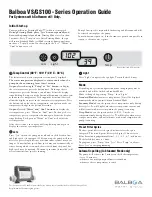
16
40.020.955 - rev.
05 - 2017
AGA 111
English
The gas enters the burner through the nozzle
and is mixed with air. The mixture is ignited
with an electrical spark. An ionisation
electrode is used to check if a flame occurs
within a few seconds. If there is no flame
within the prescribed time, the heater triggers
a fault. The ignition stops automatically as
soon as good flame has been formed.
The heater is equipped with a pneumatic
switch that monitors the hot air fan. The AGA
111 is equipped with a second pneumatic
switch that monitors the combustion air fan.
In case of a fault, the burner automat will
switch off the heater. The red lamp on the
operating panel lights up now. It is possible to
connect an external alarm (consult the
dealer).
The heater stops when the selector switch on
the operating panel is set to “0”. The heater
can be used as a fan by setting the selector
switch on the operating panel to “Ventilate”.
2.3
Main components of the heater
(fig. 3)
A Suction grate
B Hot air fan
C Gas block
D Pictograms
E Operating panel
F Combustion air fan
G Exhaust cone
H Combustion chamber
2.4
Main components of the
combustion chamber (fig. 4)
A Combustion chamber
B Ignition electrode
C Burner
D Nozzle
E Burner head
F Ionisation electrode
2.5
Operating panel (fig. 5)
A Reset button
B Indicator light (red) malfunction
C Indicator light (orange) polarisation
D Selector switch:
-
Off
-
Heat
-
Ventilate (not heat)
E Connection point for room thermostat
F Connection cable
2.6
Accessories
•
Room thermostat
•
Pre-pressure regulator
•
Outside air suction hose
•
Outside air feed-through
3
PREPARATIONS
3.1
Removing the packaging
1. Remove packaging from the heater.
3.2
Installation
1. Make sure that the heater has a stable
set-up.
2. Hang the heater on the suspension eyes.
3. Fit a gas cock with an internal
screwthread of 3/4” to the gas inlet of the
heater, see fig. 7 (A).
The heater can be positioned both
horizontally and vertically (blowing up
or down).
•
Horizontal: a minimum of 0.5 m
above the floor.
•
Vertically blowing down: a
minimum of 1.4 m above the
floor.
•
Vertically blowing up: a minimum
of 1.4 m below the ceiling.
The position of the gas regulator
block depends on the heater set-up,
see fig. 6.
Warning
The heater is suitable for a gas
pressure of up to 100 mbar.
When connecting to a higher gas
pressure, a pre-pressure regulator
must be included in the gas pipe, see
(fig. 7) (B).
















































